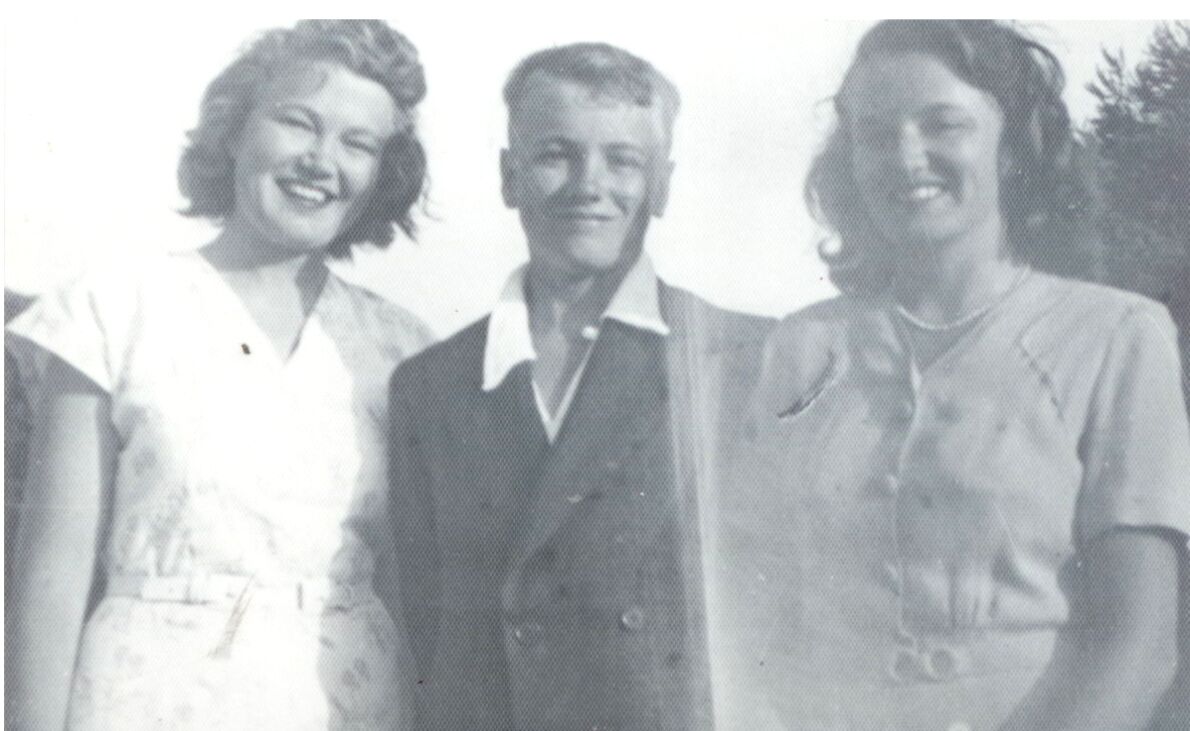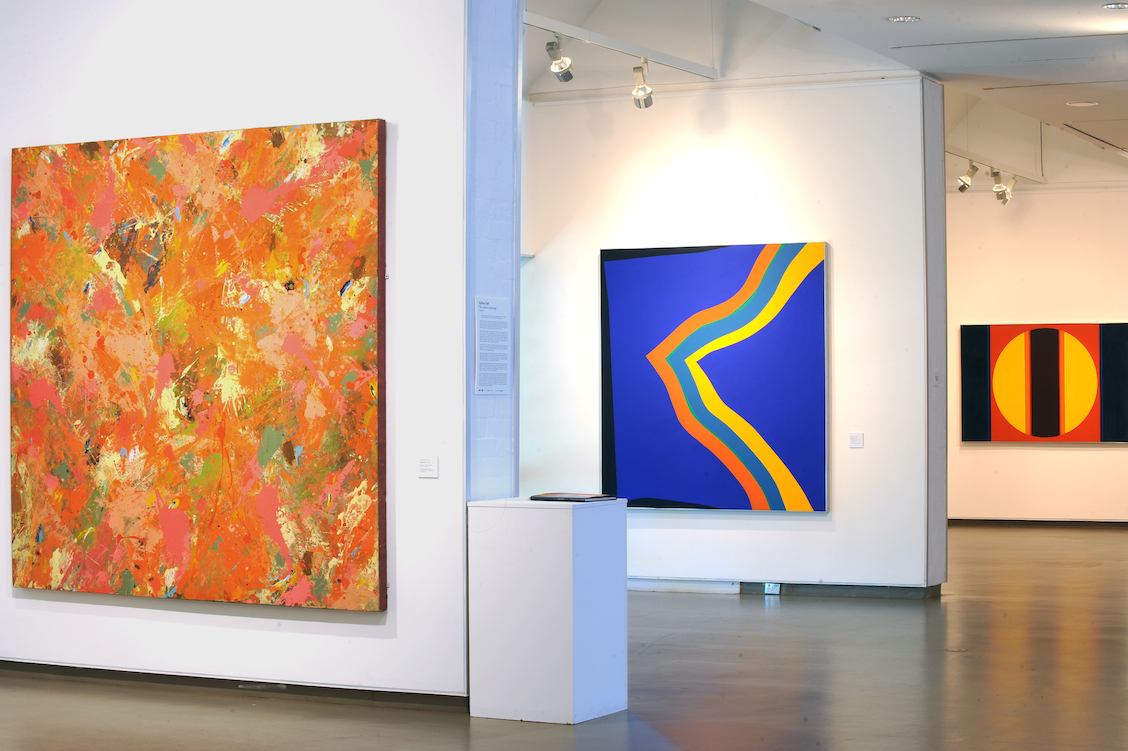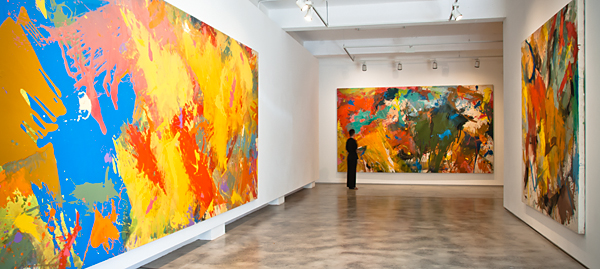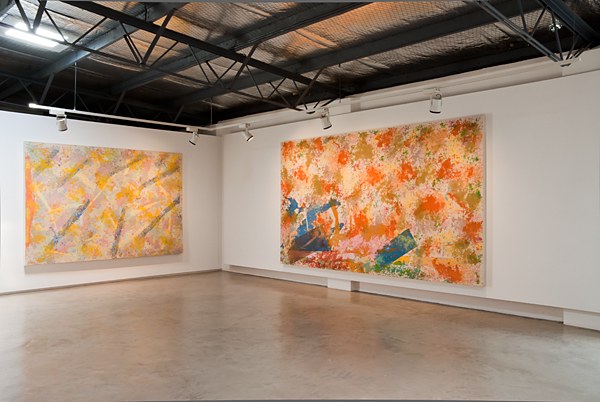1933 - 1950
Sydney Ball was born on the 29th of October 1933 in Adelaide, South Australia, to Lillian and Sidney Ball. His artistic talent emerged early in his education at Pulteney Grammar School where he won a repartriation scholarship to St Peter’s College, Adelaide.
Images on Left: Sydney and his puppy, circa 1940s; (L-R) Sydney’s cousins Lillian and Frank, Sydney, Sydney’s older sister Shirley and family friend Dawn Burrell, circa 1940s; (L-R) Sydney’s older sister Shirley, Sydney and younger sister Lillian, circa late 1940s.
1951 - 1956
Sydney Ball (middle row, third from right), circa 1950s
After leaving school Ball was employed in various jobs, including as a bank clerk and a jackeroo. He completed architectural studies and Workers’ Education Association classes with Wladyslaw Dutkiewicz and worked as an architectural draughtsman. Later, his architectural background would greatly influence his art practice as he engaged with issues of colour, form, line and volume. He joined the Royal South Australian Art Society, undertook life drawing on weekends and began exhibiting his work. Deciding to study art full-time he enquired about the entry to the National Gallery School, Melbourne; however, when he learnt that a full year would be spent sketching plaster casts, he changed his mind and decided to study abroad.
Late 1950’s to early 1960’s
Ball pursued part-time studies at the South Australian Institute, Adelaide, attending painting classes with James Cant, life drawing with John Dowie and Dora Chapman and etching with Karin Schepers. During this time New York was emerging as the centre of the contemporary art scene with many noted French artists fleeing the war in Europe. Ball wrote to Hans Hofmann hoping to attend his classes but, on learning of Hofmann’s retirement, he decided to study at the Art Student’s league of New York, close to galleries and museums. Requiring more money to cover travel expenses, he gave up his architectural studies to work in an advertising agency. During this period he exhibited in several exhibitions as a member of the contemporary Arts Society of South Australia. In addition to his day job, he started a coffee shop with two friends and by 1962 had enough money to sail to New York.
1963 - 1964
Ball commenced full-time studies at the Art Students League of New York. He studied lithography in the morning with Harry Sternberg and painting in the evenings with Theodoros Stamos. Stamos greatly influenced Ball and his time in the United States fuelled his belief that ‘art is not an object it is an experience’. In the afternoons he visited galleries and museums. He saw major survey exhibitions by Hans Hofmann, Morris Louis and Mark Rothko and was ‘knocked out’ by Matisse’s The Red Studio. He met abstract expressionist Mark Rothko. In late, 1963 he began the Band Series of vertical stripes.
Images on Left: Kingoonyah, 1963, oil on canvas, 108 x 93 cm; Poster design of Ball’s first
Sydney Ball’s statement and letter for the Ford Foundation Scholarship, circa 1964.
Ball was invited to hold a solo exhibition at the Westerly Gallery on West 56th Street , New York, and sold one painting to Australian landscape architect Bill Ashton. He received a favourable review from Thomas Newman and one brief review from Donald Judd. He participated in several group shows while at Westerly Gallery, including The New Edge, with Carl Andre, Robert Barry, Robert Huot and James Norman, all students of Robert Motherwell at Hunter College, City University of New York. He was also awarded a Ford Foundation scholarship. He showed the first of the Canto series using the vertical stripes contained within a circle. The distinctly geometric format of a circle within a square or rectangle explored the formal relationship between colour and symmetry. Ball stated that he ‘had been developing colour ideas and theories - the relationships of colour and investigations into spatial relationships - and became involved with the circle as a symbol of infinity’. The title of the series was inspired by Ezra Pound’s poems, The Cantos. Ball was introduced by Stamos to the other artists of the Irascible Eighteen group includes Willem de Kooning and Robert Motherwell, and was invited to Mark Rothko’s house for Thanksgiving dinner. He travelled to Canada, visiting Gaspe Peninsular, Quebec, and Toronto before following the Hudson River dow to New York. He met Lee Krasner, saw Jackson Pollock’s studio and sold a Canto painting to the Aldrich Museum of Art, Connecticut (first museum sale).
1965
Sydney Ball with a Canto painting in his studio at his mother’s house, Collinswood, Adelaide, circa 1960s.
Ball returned to Australia via Japan. He visited the Buddhist and Shinto shrines of Kyoto and Nara, beginning a long-lasting fascination and engagement with Asia. He was particularly interested in second and seventh century Buddhist art, especially the Wei-Jin and Han Dynasty works at Bingliza, the Tang and Song paintings and sculpture in the Mogoa caves at Dunhuang. In addition, his study of Chinese Mandarin and Korean languages enriched his appreciation of Eastern Art and philosophy. Before leaving New York, a show at the Museum of Modern Art Australia, Melbourne, was arranged with John Reed, who had suggested Elwyn Lynn see Ball’s work while on a study tour. Ball’s one man show ‘presented the local art audience with its first opportunity to view “hard-edge” abstraction as practised by an Australian artist’. The Reeds bought one Canto and a lithograph and another small Canto was purchased, yet the exhibition was not reviewed favourably. Ball, however, won the Mirror - Waratah invitation art prize with three New York Canto Paintings and was appointed Lecturer at the South Australian School of Art.
1966
Shiraz Cloud with Rainbow, 1967, acrylic on canvas, 127 x 122 cm.
Ball’s first exhibition in Sydney, at Watters Gallery, received disparaging reviews; however, Elwyn Lynn and Patrick McCaughey were staunch supporters. He commenced his Persian series, which was influenced by his interest in Persian Art and architecture and resulted in a style based on the ‘ideals of colour, line and proportion’. Curvaceous lines generated balanced yet asymmetric forms of colour, opening up the surface and introducing a new sense of space.
“The latest Persian series I’m working on is (now) based on the essence of character that I felt from seeing Persian art and architecture. But the paintings as such don’t represent Persian art or architecture but rather the feeling they create in me”
1967
Sydney Ball in the sunroom/studio of his mother’s house in Adelaide, 1969.
Ball commenced the Modular series. Art critic Bryce James would later comment that these works had come to represent a time when ‘colourfield painting had passed into something at once more durable and more conceptual, almost becoming sculpture’. In the introduction to Engine at Farmers Blaxland Gallery in 1967, Kym Bonython stated that Ball, along with Col Jordon and Ken Reinhard, was a man of his time. ‘They are concerned with modern architecture, modern forms, modern synthetics. They blend the hard edge-statements of the modern designer with the warm sense of evangelism.’ Ball also won Special Prize, Perth Festival Exhibition, Perth.
“These works are an affirmation of non-objective colour structure which looks toward a new pictorial language that connects Colour Abstraction to its history.”
1968 - 1969
Poster designed by Sydney Ball for the exhibition The Field, National Gallery of Victoria, 1968.
Ball married artist Margaret Worth in Adelaide. He won the Georges Invitation Art Prize, Melbourne and then designed The Field exhibition poster for the National Gallery of Victoria which included three of his works. Three Persian paintings were included in this exhibition. Ball and his wife returned to New York in 1969, remaining there until 1971. He finished his drawings for the new Modular works but due to the high cost of production these remained unfinished. He began colour drawings of the new Link series, which created a balance between the canvas as a surface and the use of geometric shapes.
1970
Ball’s notes on a report on the fire in his Chelsea studio, published in The Daily News, 20 January 1970.
In January 1970, Ball’s productive period was marred by a fire that destroyed his first New York studio, including all his canvases and materials. A second studio was subsequently lost over disagreements with the landlord. Ball met up with Clement Greenberg, having previously met him in Melbourne in 1968 for the judging of the Georges Invitation Art Prize. He was also introduced to Ken Noland, Jules Olitski and Jack Bush at a party hosted by Greenberg. Ball was greatly influenced by the American colourists, including Helen Frankenthaler from whom he learnt to value ‘the moment when the colour of the painting takes over’, as well as the ‘openness’ within works by Barnett Newman and Mark Rothko. He travelled the east coast of America with Patrick McCaughey and Elwyn Lynn, discussing the growing loss of focus within world art. Following Mark Rothko’s tragic suicide, Marlborough Gerson asked him to clean the studio area where he had been assisting with the assembly of Rothko’s Menial chapel commission. He was also later asked to assist in hanging Rothko’s paintings in the chapel but was unable to do so owing to previous commitments.
1971 - 1972
Ball and Margaret Worth separated. He was asked, along with Roy Edwards, to assemble Rothko’s paintings for Time-life photographers documenting works for catalogues to tour Europe. he was also committed to a show of the new Link paintings with Kym Boynton in Adelaide. He decided to return to Australia, again travelling via Japan.
1973 - 1975
Above: Ball in his Sydney studio for ABC TV documentary, Ten Australians, 1975.
Ball, in his studio with his Stain painting, Oxford Street, Sydney, Australia.
Ball brought several of the Stain paintings back from New York and they formed part of a large sell-out exhibition at the Boynton Gallery, Sydney. Further successes eventuated following exhibitions in Melbourne, Adelaide and Sydney. Maintaining a focus on colour, the Stain paintings introduced an attention to the ‘surface tension between translucence and opacity’. Ball participated in the ABC-TV documentary Ten Australians, with an international tour of Paris, Stuttgart, Milan, Florence, Rome and Venice. He took up the position as Artist-in-Residence at the University of New England and was appointed Senior Lecturer in Art, City Art Institute, Sydney College of Advanced Education. He also travelled to the South Pacific Islands to look at Polynesian and Melanesian art and artefacts.
1976
Ball bought 10 hectares of land at Glenorie to build a home and studio for himself and his partner, Lynne Eastaway. Australian architect Glenn Murcutt designed the house for the couple, and they moved in on Christmas Eve, 1983. Ball’s studio was subsequently built within just a few steps of his front door.
1978 - 1979
Article ‘Where the big ones gather’, David Dolan, The Advertiser, 1978.
Ball participated as a panel member at an Art Gallery of New South Wales seminar ‘Painting in the Seventies’. A six-month study tour of England, Western Europe, Greece, Italy, Austria and Hungary was undertaken. Of special interest were prehistoric sites, ethnographical museums and works by masters such as Tintoretto, Manet, Munch, Monet, Rodin and Vermeer.
1980s
Ball began work on a new group of expressionist paintings, introducing elements of landscape. The figurative form returned and symbolism became a means of exploring the longstanding relationship between human beings and the spirituality of the land.
1981
Article in the Sunday Mail, 20 June 1982, on the opening of the Queensland Art Gallery, showing Ball’s work Pawnee Summer (1973) in the museum’s inaugural exhibition.
Ball was a panel member for the ‘Australian and European Imagination’ seminar at the Australian National University, Canberra.
1983
Architect Glenn Murcutt completed ball’s house on his property at Glenorie. Ball had met Murcutt in 1977 through a mutual friend, landscape architect Bill Ashton. Shared values and a love of nature resulted in a modern home that was sympathetic to the landscape.
1985
Sydney Ball in Pakistan with a friend.
Ball’s teaching skills helped establish links with Chinese artists and ‘led to opportunities to tour remote regions of India, China and Tibet, and the farmed sky burial grounds of the pre-Buddhist shaman sects in the Himalayas’. He also visited the shamans of South Korea. There is a cave full of Aboriginal art near his home from which he draws animalistic-shamanist connections with those through Asia. The Buddhist art and symbols of monasteries of Hille, Bung and Thangboche, as well as the Hindu and Jaim temples in New Delhi Agra and Jaipur, were of particular interest. He was Artist-in-Residence at the School of Art, Western Australian Institute of Technology, Perth.
Late 1980s - 1990s
Ball visited China and Tibet. Of special interest were the Buddhist and B’on Symbols of lamaseries at Serra, Drepng, Ganden, Jokhang and the sacred lake of Nam-Tso. He travelled to India, trekking to Ladakh; the Buddhist monasteries of Lamayuru, Sheh, Tikse and Hemis were specifically noteworthy. He lectured on Australian Art, at the Central Academy of Art Chengdu, and The University of Tibet, Lhasa Artists Association.
A five-year contract with the Sun Gallery, Seoul, established a more formal relationship with Asia. Ball also lectured on Australian Art at the Hong-IK university, Suwon University and the National Museum of Contemporary Art, Seoul. He worked in the studio of master ceramist Kim Ki-Chul. He continued his travels throughout Asia, visiting the Wei-Jin and Han Dynasty sites of Jiayuguan, Mogao caves at Dunhuang, the Buddhist caves at Bingliza, Lanzhou, Datong and Luoyang, and the Tang and Song dynasty temples at the Wutai Mountains. He also travelled to the Nusa Tenggara Islands visiting animist villages in Lombok, Sumbawa and Flores.
2000s
Ball continues to exhibit widely in solo group shows. While his earlier works are being included in surveys of twentieth century Australian Abstraction, he has continued to explore the relationship between colour and line. Again drawing on his love of architecture, he began a new series, Structures 1 in 2002 and Structures 2 in 2006, in which he uses form and colour simplicity as a means if exploring picture and abstract concepts. His love of modernist architecture has led him to engage with the ideas of architects Mies van der Rohe and Zaha Hadid and their practice of simplifying design concepts through a refinement of structures. Ball explains that ‘colour chicness and intensity is the primary importance and that is achieved through the refinement of form and colour simplicity.’
2001 - 2005
Purple Shape with Rectangle (Turquoise), 2003, acrylic on canvas, 79 x 92 cm.
In the new millennium, a resurgent interest in colour abstraction, both within Australia and internationally, saw a refocusing of academic and critical interest in Ball’s work. During this time he commenced two new series, Structures 1 and Structures 2, which investigated abstract architectural concepts. Here, Ball’s exploration of the work of architects Mies van der Rohe and Zaha Hadid, and their vision of form and structure, resulted in direct yet beautifully simple forms.
This led to critical museum surveys such as Australian Colour Field and Hard Edge Painting of the 1960s and 1970s, Art Gallery of NSW, Sydney, 2001; Fieldwork: Australian Art 1968-2003, Ian Potter Centre, National Gallery of Victoria, Melbourne, 2003; and 6 Years Abstraction, Tarrawarra Museum of Art, Melbourne 2005.
2008
A major survey of Ball’s oeuvre, Sydney Ball: The Colour Paintings, curated by Anne Loxley, was presented to coincide with his 75th birthday in 2008. Drawing from public and private collections, the exhibition examined the interests that have consumed this prolific and committed artist: abstraction and colour. Curator Anne Loxley’s selection brought together the finest examples of work from all of Ball’s colour periods –from his flat colour beginnings to gestural abstraction and his eventual return to flat colour. The survey first showed at the Penrith Regional Gallery & Lewers Bequest, Sydney, and subsequently traveled to the McClelland Gallery & Sculpture Park, Melbourne and The Anne & Gordon Samstag Museum of Art, Adelaide.
Images on Left: Installation views of Sydney Ball: The Colour Paintings, Penrith Regional Gallery & The Lewers Bequest, 2008.
Above: Ball speaking about his exhibition, Sydney Ball: The Colour Paintings 1963 - 2007, the Anne & Gordon Samstag Museum of Art, Adelaide, 2009.
2010s
In 2010 Ball began work on his first Infinex series, which readdressed interests of space, form, light and colour expressed in the Modular series 40 years earlier. Ball produced a rich collection of works, which were exhibited in Infinex I (2011), Infinex II (2012) and Infinex III (2014) at Sullivan+Strumpf, Sydney. In the geometrical and architectonic manifestation of dynamically colourful creations, all three series reflect the progressive development of Ball’s practice reaffirming his position as a pioneer in his field.
Three monographs on Ball’s work were published during this period: Sydney Ball: The Colour Paintings 1963 - 2007 (Penrith Regional Gallery & The Lewers Bequest, 2008); Modular and Infinex - 1967 to now (Sullivan+Strumpf, 2016); and The Stain Paintings 1971 - 80 (Sullivan+Strumpf, 2016).
2013 - 2015
It was during this same period in 2013 that Ball turned 80 years old and celebrated his achievements with a retrospective exhibition, The Stain Paintings, at Sullivan+Strumpf, Sydney. From this exhibition, the Art Gallery of NSW acquired Great Falls (1976), the largest Stain painting Ball ever produced. Still working beyond the 50th year of his career, Ball continues to create further dynamisms of colour abstraction in his new series Infinex IV: Chromix Lumina in 2015.
Left: Installation view of The Stain Paintings at Sullivan+Strumpf, Sydney. Image courtesy of the gallery.
“For me it’s the scale which envelops the viewer; that whole nebula of colour, the ocean of colour, which just soaks you in.”
Ball gifted over 30 of his works to the University of South Australia, Adelaide, in 2013. This prestigious gift, comprising over thirty important works and worth more than one million dollars, is by far the most valuable gift of Australian art ever made to the University. The Sydney Ball Gift are installed in the University’s Sir Eric Neal Library in February 2015, celebrating the artist’s long and impressive career and considerable impact on Australian art, and recognises this wonderful act of generosity to the University.
Left: Ceremony of installation of The Sydney Ball Gift at the University’s Sir Eric Neal Library, attended by ___________________________, ___________, ________________, _______________-. Images courtesy of the University of South Australia.
In the same year, the University of South Australia awarded Ball an honorary doctorate in recognition of his services to education and the arts. The honorary degree of Doctor of the University is awarded to a person of eminence who has made a distinguished contribution to public service or a field of academic endeavour. This great honour recognises Ball’s significant contribution to the progression of abstract expressionism in Australian contemporary art.
Left: Ball, in his graduation gown for accepting his PhD at University of South Australia.
2017
Ball’s last museum show of his lifetime, Superposition of three types, curated by Alexie Glass-Kantor and Talia Linz at Artspace, Sydney. Ball’s last work, Chromix Lumina #12 (2016), a large square composed of six pastel-coloured diagonal aluminium panels placed on the gallery floor, received high praise in Frieze Magazine: “Undoubtedly one of the best pieces in the exhibition, (…) a fitting end to his career, emanating the energy of a much younger artist.”
On 5 March 2017, Ball passed away after suffering a stroke two days before. His memorial service was held at the Art Gallery of NSW and was attended by hundreds of friends, family and supporters. Ball is survived by his partner, Lynne Eastaway.
“You could not see daylight between Syd Ball the man, and Sydney Ball the artist. The man was the artist and the artist was the man. Few are so well integrated.”
“He was driven by an enduring fascination with colour abstraction and the possibilities of form (...) one of the true trailblazers of abstract painting in Australia”
Posthumous
In 2018, Ball was included in Superposition: Equilibrium and Engagement as part of the 21st Biennale of Sydney, curated by Mami Kataoka. His work, Black reveal (1968-69) is exhibited alongside his Modular sketches, a series of fourteen preparatory studies on paper. These were accompanied by three of Ball’s sketchbooks; the detailed pages providing further insight into the artist’s captivation with form, colour and light.
Most recently, Ball was included in the National Gallery of Victoria restaged its landmark exhibition, The Field for the museum’s 50th anniversary in 2018 as The Field Revisited.
Images on Left: Installation view of Superposition: Equilibrium and Engagement, part of 21st Biennale of Sydney, Art Gallery of New South Wales, 2018. Image courtesy of the Art Gallery of New South Wales.
In October 2018, his first posthumous solo exhibition, Infinex V, was presented at Sullivan+Strumpf in Sydney. The show had been planned during Ball’s lifetime to mark what would have been the artist’s 85th birthday. The Infinex V series was planned by Ball as a series of large-scale compositions. Fabricated by Urban Art Projects, the series has been realised according to the artist’s exacting instructions in automotive enamel on aluminium, a method of manufacturing he devised out of physical necessity at the age of 81 in 2014. As a way of honouring Ball’s working process, the exhibition presents both the finalised large-scale works on aluminium, a number of which have been realised posthumously, alongside a small series of intimate works on paper from 2013 which have never before been exhibited.
Images on Left: Installation views of Infinex V at Sullivan+Strumpf, Sydney, 2018































































